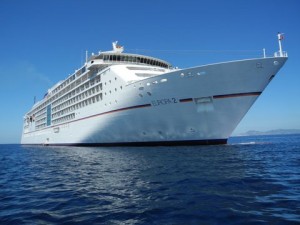After posting my recent piece on repositioning cruises, I received this guest post entry from reader Suzanne Meades, offering some reasons why baby boomers might prefer taking a cruise ship to flying to and around Europe.
And for those boomers who have the time, I couldn’t agree more.
Both ocean and river cruising are big with boomers. A transatlantic cruise — fairly rare these days, except for repositioning cruises — evokes particular nostalgia for me, since a Spanish steamship took me across the Atlantic on my first trip to Europe in college. I even have a medal for winning the shipboard table tennis tournament, no easy task since the ship was rocking and rolling through the waves during my final match. At least, I think that medal is hiding around here somewhere…
As for seeing Europe by cruise ship, I’ve seldom had better experiences on the Continent than going port hopping through the Mediterranean and Adriatic seas, or cruising some of Europe’s major rivers.
Suzanne’s post is something of a primer for those who may have rejected the idea of a European cruising vacation for one reason or another. Here’s what she has to say:
By Suzanne Meades
Why is cruising catching on with boomers, when flying is so much faster? Here are a few reasons, as well as some cruising hints and tips:
Cruising is a wonderful way to explore the world in luxury and at a relatively relaxed pace. While many people still associate cruising with an older demographic — age 70 and above — recent studies have shown this to be a myth.
The Cruise Lines International Association found that the demographic profile of the average cruise passenger would correspond to a 55-year-old university-educated person, married, employed, and with an annual income over $75,000.
Of course, that doesn’t mean you won’t find plenty of younger people on their honeymoons, older passengers in their twilight years, or recent retirees on your ship: but the variety of people onboard is part of what makes cruising so interesting.
The Cost Impact of Cruising
Many people consider cruising to be an overly expensive option, and a luxurious way to travel to and around Europe.
And it’s true, most cruise vacations aren’t cheap. But unless you’re prepared to take red-eye flights on discount airlines and stay in inexpensive hostels a la college students, there really isn’t a ‘cheap’ way to travel around Europe.
When you look at the costs of cruising and consider that you won’t have to pay for airfare, hotels or even a number of your meals during your European trip, cruising suddenly begins to look like a much more cost-effective travel option.
The right ship for everyone
The right cruise ship is out there for everyone, no matter what your budget is or the type of experience you’re looking for.
If you’re interested in cultural experiences, then look to the Cunard line, which offers fascinating and fully comprehensive cultural enrichment programs on their transatlantic liners — one of the few lines to still make crossing the Atlantic a trip unto itself.
Alternatively, if you’re looking for a more youthful ‘party’ atmosphere, try Carnival Cruises. [Editor’s note: Carnival doesn’t sail to Europe just now, but it does have a robust presence on this side of the pond.]
If your idea of a dream cruise is to indulge yourself and experience complete luxury, then Crystal cruises would probably be an ideal first choice for you.
No matter which kind of cruise ship you choose, cruising allows you to embrace your personal space in a way that is simply not possible when you fly (unless you can afford to plump for a first class seat!).
The food is excellent, you can wear your finest formal wear if you wish on lines like Cunard, and you can experience several different countries and cultures without the hassles and headaches that come with transferring flights and navigating passport controls, carrying your luggage to impossible-to-find hotels, and negotiating and organizing your own day trips to the most important historical sights.
Environmental impacts
Finally, it’s worth considering the environmental impact of taking a cruise, rather than flying across the Atlantic and then to and from various European destinations.
Traditionally cruising has had a very bad environmental reputation, but the industry as a whole is taking steps to improve its policies and become more environmentally responsible.
These days, all cruise liners have to meet vigorous environmental targets and many liners — such as the Queen Mary II — take this a step further by having zero discharge policies.
When you consider that you will spend much of your vacation time on the ship itself (apart from when you arrive in port and take day trips) this makes the carbon footprint involved in taking a cruise much less problematic.
If you do have environmental concerns and like to be as carbon neutral as possible, then look for a line that has a good environmental record: Carnival, for instance, has recently announced ambitious targets to reduce the environmental impact of its ships.
You can even source a carbon offsetting company to take care of any additional impacts of your vacation and enjoy your trip without any guilt at all.











Leave a Reply